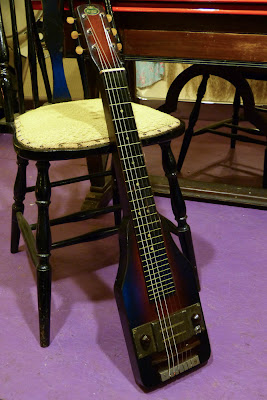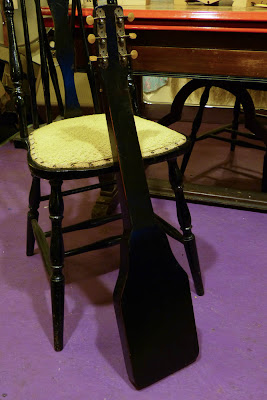c.1940 Regal Lap Steel Guitar
I'd be willing to wager that this is more late 1930s than 1940s and onward. This is a Regal-branded (and made) lap steel made from one piece of solid birch. It's got a standard 23" scale and a two-blade pickup that sounds full, warm, rich and wonderful.
My work included rewiring the instrument (replaced the pots, reused the old capacitor, and installed a new jack) as well as installation of a replacement bridge (the original floating bridge was long gone), cleaning, and setup.
It's a cool instrument and definitely has that late-30s Chicago feel to it. I currently have it tuned in open E since I only had a regular set of electric 10s on hand to string it with.
Simple body. Compared to many lap steels, this one is nice and light in the lap despite being thicker than the average Chicago build.
Bone nut, translucent tuners, fun green Regal label. The top is sunburst on the body and headstock. The fingerboard is a plain slab of wood (probably dyed maple) with sprayed-on markers.
The Kluson tuners are original and work just great. I love the buttons.
This model would have had a floating bridge that sat on the body via tension. I've replaced this missing bridge with a rosewood mandolin-style bridge slotted for guitar spacing. I also installed posts and those two nuts sitting under the bridge allow for string height adjustments. I made it this way because some folks like their strings closer to the pickup and some like them higher and a little farther away.
The pickup, tone and volume pots, and jack are all mounted on one piece of cast metal with a "crackle" finish applied to the top. As stated, I had to rewire the whole thing as the old pots had given up the ghost. Note the new jack -- originally this had a little housing for an attached cord's end to come out.
The cord was missing and those things are horrid anyway (they always get pulled out and muck up the wiring) so I ground down the little "hump" for the cord-out spot and installed the jack in the same location. This isn't as pretty but it's 300% more practical.
The bakelite radio knobs are excellently cool, by the way!
It has its original case, too, though it's somewhat beat up. A bit of duct tape around the edges will make it more travel-friendly but it does close and serve to house the instrument for light travel as-is.











Comments
thanks!
Any guess as to what one of these in good, functioning condition would go for? I’m looking to buy something affordable to introduce myself to lap slides and maybe eventually to a pedal steel. I came across one of these in my search, but I have no frame of reference re: price.
Thanks,
Brian